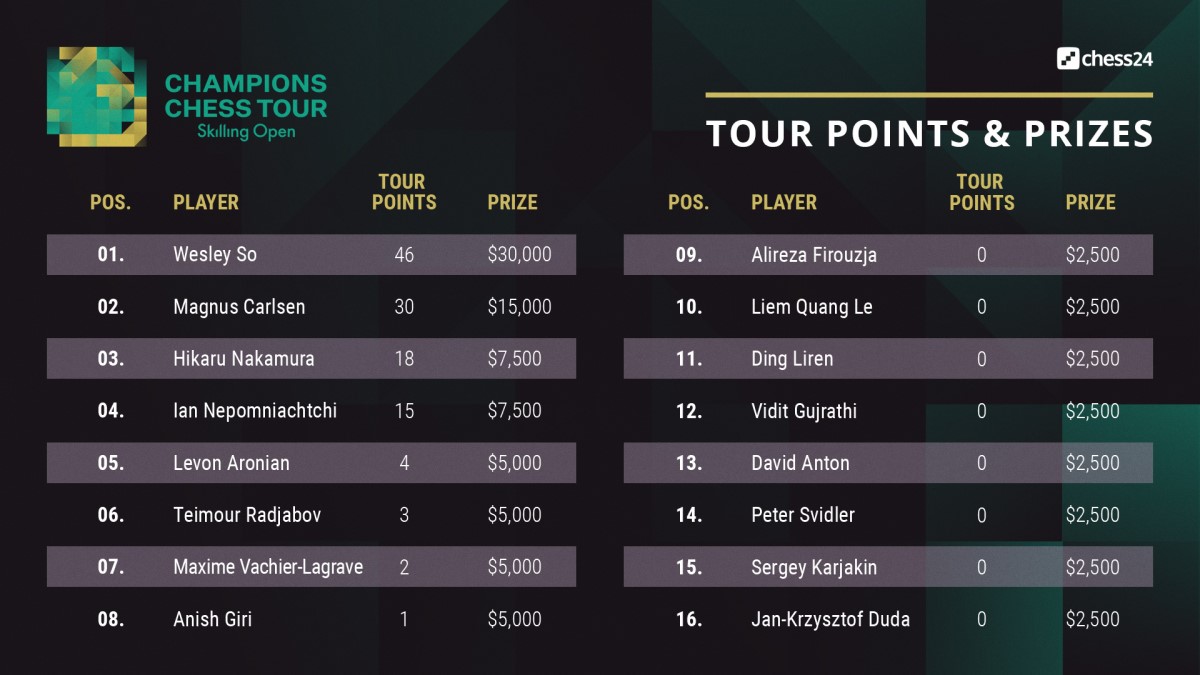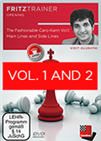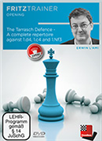A semi-ruined birthday
Magnus Carlsen became the world champion in 2013, eight days before his 23rd birthday, on 22 November. Almost exactly a year later, on 23 November 2014, he defeated Vishy Anand for a second time in a row to retain the title. The Norwegian defended his crown in 2016 and 2018, defeating Sergey Karjakin and Fabiano Caruana on the 30th and the 28th of November respectively. Playing for the highest stakes around the date of his birthday seemed to work wonders for the champ.
Of course, this is all superstition, and Carlsen has demonstrated that he can beat anyone in the world no matter the time of year. On this occasion, he was defeated by Wesley So in the inaugural tournament of the 2020-21 Champions Chess Tour. So courteously acknowledged the fact that he did it on his opponent’s birthday:
First of all I’d like to apologize to Magnus for semi-ruining his birthday, but I gotta try to win from time to time. You don’t want him to win ten tournaments in a row.
 Scarcely any world champion has managed to captivate chess lovers to the extent Carlsen has. The enormously talented Norwegian hasn't been systematically trained within the structures of a major chess-playing nation such as Russia, the Ukraine or China.
Scarcely any world champion has managed to captivate chess lovers to the extent Carlsen has. The enormously talented Norwegian hasn't been systematically trained within the structures of a major chess-playing nation such as Russia, the Ukraine or China.Throughout the event, Carlsen was not his usual dominant self over the (digital) board, as he struggled to take down Anish Giri and Ian Nepomniachtchi in the previous stages of the knockout. The world champion had also mentioned that he did not feel he had played all that well during the preliminaries. Nevertheless, given his strength, he managed to get first place in the round-robin and reach the final in the knockout.
For chess professionals, it is not all about the results though, as So noticed his opponent was not playing at his full potential:
I don’t think Magnus is in his best form right now, because he missed a lot of chances, and he made a lot of mistakes here and there which would have sealed the match. [...] When he has a good day, he is basically unstoppable.
Talking to the commentators after the loss, Carlsen looked saddened by the loss, and also exhausted after nine days of hard-fought chess. Anyway, he clearly stated that his rival was the deserved winner, emphasizing that he would give no excuses for the loss. The world champion quipped:
Fortunately, I qualified for the Major (smiles).
Carlsen referred to the fact that the top 8 players from this tournament automatically get a qualification spot in the next event, which in this case will also be the first ‘Major’ of the tour, to kick off on 26 December.
By the way, Spanish GM David Antón received the spot reserved for the player who gets the most votes in an online poll out of the eight participants that did not make it to the knockout stage in the previous event.

Click to enlarge
Game 1
Carlsen played the Caro-Kann all three times he had the black pieces on Monday. He was clearly well prepared given the manoeuvre he used on move 9 of game 1:
 The Caro Kann is a very tricky opening. Black’s play is based on controlling and fighting for key light squares. It is a line which was very fashionable in late 90s and early 2000s due to the successes of greats like Karpov, Anand, Dreev etc. Recently due to strong engines lot of key developments have been made and some new lines have been introduced, while others have been refuted altogether. I have analyzed the new trends carefully and found some new ideas for Black.
The Caro Kann is a very tricky opening. Black’s play is based on controlling and fighting for key light squares. It is a line which was very fashionable in late 90s and early 2000s due to the successes of greats like Karpov, Anand, Dreev etc. Recently due to strong engines lot of key developments have been made and some new lines have been introduced, while others have been refuted altogether. I have analyzed the new trends carefully and found some new ideas for Black.
The commentators quickly noted that 9...Bf8 can only be played if you have checked the ensuing lines deeply with a computer. Of course, that move by itself did not give Black a clear advantage — it was So’s imprecision on move 16 which gave Carlsen the upper hand:
White was not ready for the 16.c4 pawn break, as Black had 16...dxc4 17.Qxc4 Nxd4, when So could not capture with 18.Nxd4 due to 18...Nxe5 19.Qc3 Bb4 with a clear advantage for Black. After the text, the game continued 18.Qxd4 Qxb3 19.Bxg6 fxg6 20.Qe4 0-0:
Black is already in the driver’s seat, but kudos should be given to So for finding the most trying continuations — here he played 21.Bxh6, to which Carlsen responded with the strong 21...Rf5. After 22.Be3 Qd5 22.Qxd5 (22.Qc2 was better, keeping the queens on the board) exd5 23.f4 Carlsen had the initiative.
The world champion correctly gave up an exchange and pushed his passed pawn on the d-file to convert his advantage into a win. It had been a tough struggle, and Carlsen ended up on top — with the black pieces.
Game 2
So immediately bounced back, winning with black using the same variation that gave his opponent a win in the first game of Sunday’s mini-match. It was the American’s turn to show a fine retreating move with the black pieces:
 Are you looking for an active defence against 1.d4? Look no further! The Tarrasch Defence (1.d4 d5 2.c4 e6 3.Nc3 c5) is one of Black's most ambitious ways to meet 1.d4.
Are you looking for an active defence against 1.d4? Look no further! The Tarrasch Defence (1.d4 d5 2.c4 e6 3.Nc3 c5) is one of Black's most ambitious ways to meet 1.d4.
At this point, Carlsen considered two bishop moves, and chose the wrong one. He later confessed that he failed to correctly assess the difference between 17.Bg5 and his choice of 17.Bd4 which was a big mistake. After 17...Bd6 18.Na4 Rxc1 19.Rxc1 Ke7 20.g3 Rd8 21.Be3 Black was simply a pawn up.
The Filipino-born grandmaster showed good technique to convert his advantage into a win with a pair of knights against Carlsen’s bishop pair:
The difference in activity is huge. Carlsen resigned on move 60.
Games 3 and 4
Clearly the most dramatic game of the day was the third rapid encounter. Out of a sharp Caro-Kann, So erred on move 18:
 The Caro-Kann Defence is one of the most solid replies for Black after 1.e4. Bologan's choice of the Advance Variation for White is because of the complex strategical play in which White has a long-term space advantage.
The Caro-Kann Defence is one of the most solid replies for Black after 1.e4. Bologan's choice of the Advance Variation for White is because of the complex strategical play in which White has a long-term space advantage.
18.Bb5 is a very tempting move, but also a mistake, as Black could respond with 18...Nf4, when after the forced sequence 19.Bxd7 Nxh3+ 20.gxh3 Bxd7 21.Rxe7 Bxd7 22.Nxd5 Bd6 Black is clearly for choice. However, Carlsen did not find the refutation and went for 18...Qc8, allowing White to equalize with 19.Rxf6 Rxf6 20.Qxc8 Rxc8 21.Bd3:
The draw was signed ten moves later.
After the thrilling third encounter, the players decided to take it easy in the final rapid game of the day, with a quiet variation of the already-drawish Berlin Defence appearing on the board. The point was split after 23 moves.
Select an entry from the list to switch between games
Blitz tiebreaker
In yet another complex Caro-Kann, White emerged with a slightly better position in an endgame with bishops, rooks and pawns on the board:
Carlsen needed to be careful here, as 34.c6 is a move that requires precise calculation. It is difficult to blame the world champion for not finding the right way forward in a blitz game, however — his 34...d4 was the losing mistake. After 35.Rf1 Black is forced to go 35...Rh8+ 36.Kg1 Rh1+ 37.Kf2 Rxf1 when White gets a winning position with 38.Bxf1:
38...Bxc6 39.b5 Bd7 40.a6 bxa6 41.bxa6 d3 42.Bxd3 Ke5 43.a7 Bc6:
So played 44.Bf1 and Carlsen resigned, as there is no way to stop the passer on the a-file after the threatened Bg2.
Wesley So was never in real trouble in the last blitz game of the event. A draw was agreed after 46 moves, giving the Filipino-born star tournament victory.
Select an entry from the list to switch between games
Links
























